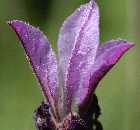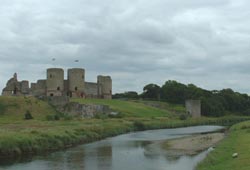Mind Streaming
John Coxon's Online Journal|
Archive Search |
| Links |
|
and s-integrator |
Saturday, July 12, 2003
LAVENDER
WHAT'S IN A WORD ?
Monday, July 07, 2003

I now realise I have a chronic case of lexiphilia and I guess I am incurable. I name this illness lexiphilia, unless it already exists, from the Greek lexicos (pertaining to words) and philos (meaning dear or loving (of))
I have loved words since I was a kid, especially ones from Latin or Greek, even though I never studied eiher langauge formally at school. It was never enough for me just to know what a word meant, I also wanted to know the history of the word, how it came into use and how it changed over the centuries and developed additional meanings from the original use. I never did Latin at school, but somehow have always stored in my mind the derivations of most of the words whose origins I'd researched.
There can't be too many people who actually own the "most comprehensive etymological dictionary of the English Language", the wonderful ,1000 plus paged Oxford Dictionary of Etymology. It is a learned work, originally edited by the scholar with the glorious name of C.T. Onions. It has details of the linguistic origins of 38,000 words. Dr. Onions joined the staff of the Oxford English Dictionary in 1895, and was the last editor of the original Oxford English Dictionary(O.E.D), in its present form, the standard authoritative dictionary for serious students of British English.
For Dr.Onions, the etymological dictionary was a life-time lexicographical labour, and, the book has been described , by the publishers, as a monument to him and as the "harvest of his lifetime of learning."
Tragically, C.T. Onions died before his labour of love was first published back in 1966.
(lt is staggering to note, incidentally, that the Oxford University Press printed its first book in 1478 just two years after William Caxton set up the very first printing press in England. The OUP is actually a department of academically prestigious Oxford University.) I don't think you will be rushing out to get yourself a copy. The price would be off putting for most ; a cool £60 British Sterling ( that's about $98 US Dollars ) but with me it's a love thing.

As an example of the use of the Oxford Etymological Dictionary, I have posted this photograph of one of the lavenders which grow in my garden, taken with my new digital camera and whilst I was experimenting with the new zoom macro lens I bought very recently. I'll be posting this shot over on my FOTOLOG later today. I am also e mailing it to a friendly on-line acquaintance in California , Cathe Gordon , who has a wonderful illustrated web site (Click her name to visit her site )devoted to her passion for lavenders and she is also one of the Internet's leading authorities on them. I'll be writing, partly to check if this variety is indeed French lavender of Lavandula Stoechas as I think it is correctly named.
Now the origin of the latin suffix Stoechas to the word lavendula ( botanical name for the genus of lavenders) isn't in my special dictionary, but the origin of lavender is. (Stoechades , incidentally, was a name given by the Greeks to a group of Mediterranean islands on the Cotes D'Azur. It was a tradition with them to name island groups according to their configuration, in the same way that we name and thus can identify groups of stars in the sky. Stoechades also came for the Latin word for rows, and , apparently this variety of lavender, even then important for its medical properties, grew prolifically in this 'row' of islands.
The derivation of the word lavender, according to Dr.Onion's dictionary is almost certainly connected with the Latin lavare (lave) = to wash , as in the modern French verb, laver = to wash, and the first use in writing ( lavendula vera , Dr.Onion tells us, was in the 15th century. Regrettably, as often happens when researching the development of the use of a word from way back, the etymologist can only confirm with reasonable certainty that the flower name, lavender, comes from a classical word source connected with washing. "The sense development", he tells us , "remains obscure." That is, even though we know that, for example, the Romans used lavender in their baths as a fragrance, that's as near to knowing , with any degree of certainty, what the orginal connection was between this familair and sweet fragrant flower and washing. I'd hazard the guess that, in the process of washing, Roman's used the essence of the flower as a widely available fragrance and hence the word derived from the bathing word association.
johncoxon 1:00 AM - [Link] - Comments ()
...
WHAT IS THIS LINK BETWEEN THIS MEDIEIVAL PILE OF WELSH STONES AND CHARLES, THE CURRENT PRINCE OF WALES ?
Taking the country road to the North coast seaside towns of Prestatyn and Rhyl, we called in to look at elegant ruins of Rhuddlan Castle, (now owned and maintained by the National Trust )

It stands on the banks of the sleepy River Clwyd. It isn't a Norman castle but is from the Medieval times of the Plantagenet monarchs of England. There was an earth and timber fort in this vicinity built 924 AD by Edward the Elder, (King Alfred's son.) The Normans built a 'moat and bailey' stone castle here around 1073. What you see today though was commissioned by King Edward the First (1239-1307)(Nicknamed "Longshanks" because he was really tall i.e had long 'shanks' or legs )It was finished in 1282. Edward built quite a few like this to keep the Welsh under his control once he had conquered them and had made Wales a part of his kingdom.
Now the British flag, (the Union Jack) is a composite of the flags of St Patrick (Ireland), St Andrew (Scotland) and St.George ( England) But there is no part of the Welsh flag on it , even though Wales is a part of the kingdom. Wales is not a kingdom but a Principality. Ironically up till the time this castle was completed, Wales was ruled by a series of regional noble princes who were troublesome to the English. They wanted to retain their autonomy and independence from England but Edward had other plans. Edward kept up an aggressive foreign policy, and directed a campaign against the Welsh forces of Llywelyn ap Gruffydd from 1277.
But, when Llywelyn ap Gruffydd was killed in a battle with Edward's forces in 1282, that was the end of any idea of Wales remaining independent. Edward declared his eldest son the very first Prince of Wales in 1301 and the country was divided up into shires and administered under English laws by Edward's justices.
(The building today is in a rather sorry state The National Trust charge £2 per adult to walk around the ruin. We just admired it from the outside.)
There is something therefore ironic in the flying here of the
Welsh flag> on one of the surviving high turrets of the castle,when you recall it was a place that helped see an end to Welsh dreams of remaining free from English rule all that time ago. Edward Longshanks would certainly be incensed if he were around today and saw it flying on his castle on what was a symbol of his power over the Welsh. So in fact , Prince Charles owes his title to the efforts of Edward 1 and the presence in those early dyas of castles like this one at Rhuddlan. In effect, Llwelyn was the last real Prince of Wales.
For a detailed and photo-illustrated history of this castle click on
Rhuddlan Castle which also contains similar extensive information on one hundred Welsh castles.
Click here for the listings of all the castles described and illustrated on this comprehensive web site
WELSH CASTLES LISTINGS
If you have an interest in any of the Kings of Queens of England and Scotland, the Official web site of the British Monarchy, run from Buckingham Palace, has a very readable short guide at
HISTORY OF THE MONARCHY
Click here for a history of the once powerful Welsh monarch
The Last Real Prince of Wales
johncoxon 8:20 PM - [Link] - Comments ()
...